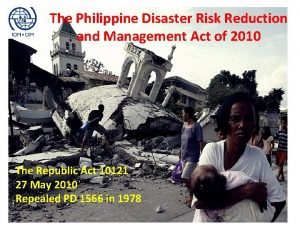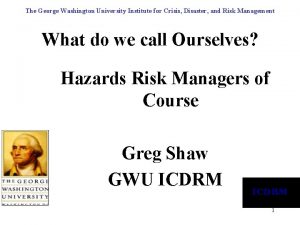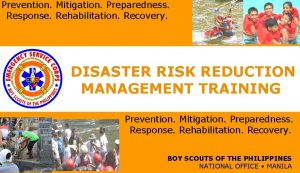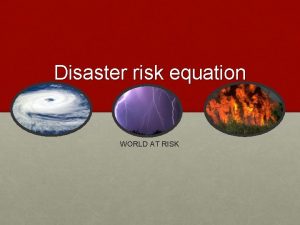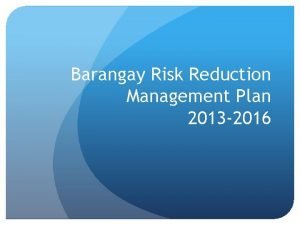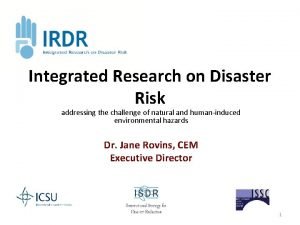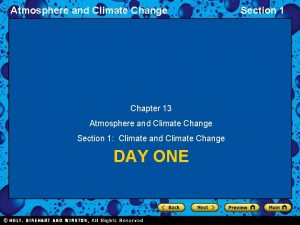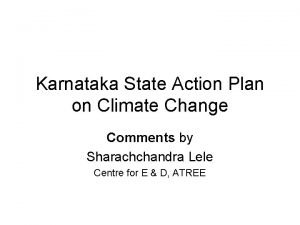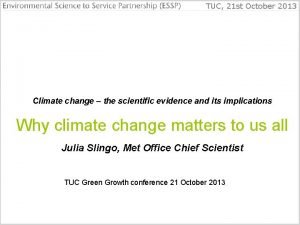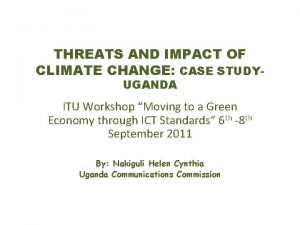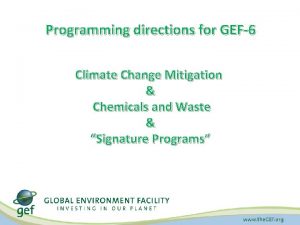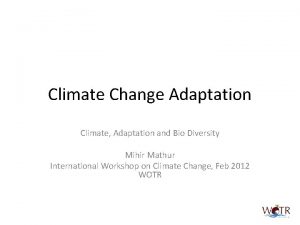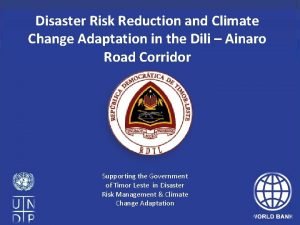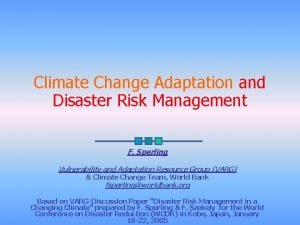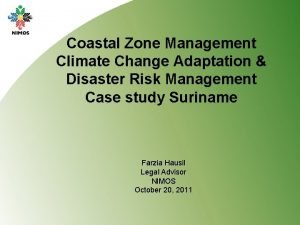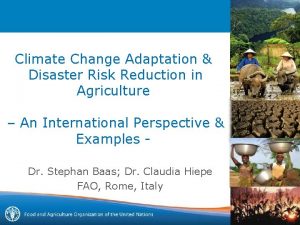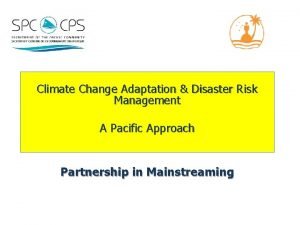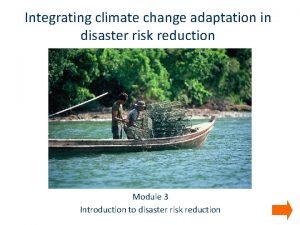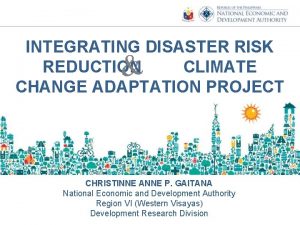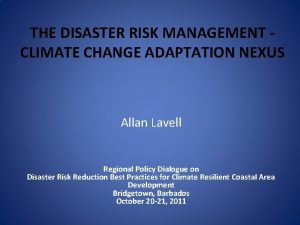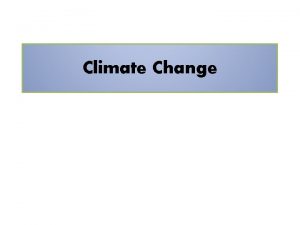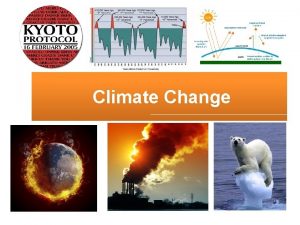Integration of Climate Change Adaptation and Disaster Risk
























- Slides: 24

Integration of Climate Change Adaptation and Disaster Risk Reduction: Intent and Practice Jeremy Collymore Executive Director, CDEMA UNFCC WORKSHOP Identification of Gaps and Challenges in the Implementation of Risk Management Approaches to the Adverse Effects of Climate Change 10 -12 October 2011: Lima, PERU

Introduction l l Climate-related disasters have repeatedly set back development With climate change – – l The occurrence of hazards is likely to increase Impacts on ecosystems, reductions in water and food availability and changes to livelihoods will increase vulnerability The poor, and poorer countries, are hit hardest

CATASTROPHIC IMPACTS NORMING l l l l Floods and forest fires Australia 2009/10 Floods in Brazil 2009 Flood in United Kingdom 2009 Drought in Somalia 2011 Floods in Pakistan 2011/2010 Floods in Saint Lucia 2011 Tornados in the United States 2011 China Floods 2010/2011

REALITY OF CATASTROPHY l l South Asia economic losses to GDP 15 times higher in relation to OECD l ISDR 2009 High economic vulnerability is associated with low national savings 59 % SIDS and 67% LLDCS high /highly vulnerable to economic loss

Where do we begin? l l Strong correlation between climate change and disasters In terms of adaptation, “Disaster risk reduction is the first line of defence against climate change impacts” Adaptation that is linked with DRR begins by addressing existing vulnerabilities to current climate events - a “no regrets” approach Good progress has been made, but more is needed to tackle vulnerability and its causes

Climate Change and Disaster Risk Reduction Linkages between Climate Change and Disaster Agendas Climate change: slowonset, hydrometeorological hazards Natural hazards: rapidonset, hydrometeorological & geophysical hazards Both share a common risk management agenda After G. Cambers

Regional Framework for Achieving Development Resilient to Climate Change (2009 -2015) VISION Building Regional Resilience to a Changing Climate Objective To establish direction and to continue to reduce vulnerability in the region and build resilience to the impacts of GCC. SE 1: SE 2: Mainstream CCA Promote the implementation of specific adaptation measures to address key vulnerabilities strategies into the sustainable dev. agendas 7 SE 3: SE 4: SE 5: Promote actions to derive social, economic and environmental Promote actions to reduce the vulnerability of natural and human systems to reduce greenhouse gas emissions benefits from the prudent management of standing forests

Enhanced CDM Strategic Framework (20072012) GOAL Regional Sustainable Development enhanced through CDM PURPOSE To strengthen regional, national and community level capacity for mitigation, management, and coordinated response to natural and technological hazards, and the effects of climate change. OUTCOMES Enhanced institutional support for CDM Program implementation at national and regional levels 8 An effective mechanism & programme for management of comprehensive disaster management knowledge has been established Disaster Risk Management has been mainstreamed at national levels and incorporated into key sectors of national economies (including tourism, health agriculture and nutrition) Enhanced community resilience in CDEMA states/ territories to mitigate & respond to the adverse effects of climate change & disasters

Mainstreaming Climate Change into Disaster Risk Management for the Caribbean Region (CCDM) Project 9

CCDM RESULTS AND ACTIVITIES 10

The Model Programme and Plan of Action for Integrating CCA and DDR “Blue print for national level integration of climate change adaptation and disaster risk reduction” 11

ISDR 6 STEPS FOR MAINSTREAMING 1. 2. 3. Mapping institutions, policies and mechanisms already in place for reducing disaster risk and dealing with climate change; Taking stock of the available information on hazards, exposure, vulnerabilities and risk assessments; Convening multi-stakeholder discussions to review information and identify opportunities to harmonize policy and address capacity gaps; 12

ISDR 6 STEPS FOR MAINSTREAMING 4. 5. 6. Initiating capacity development activities to build or strengthen coherent approaches to climate change adaptation and disaster risk reduction; Designing joint project initiatives that address both climate change adaptation and disaster risk reduction. Conducting adaptation planning with a multi-sectoral, development based approach and centralized oversight responsibility 13

ENHANCED COMPREHENSIVE DISASTER MANAGEMENT PROGRAMME FRAMEWORK (OUTCOME 4) Output 4. 1 Preparedness, response and mitigation capacity (technical and managerial) is enhanced among public, private and civil sector entities for local level management and response Output 4. 2 Improved coordination and collaboration between community disaster organizations and other research/data partners including climate change entities for undertaking comprehensive disaster management Output- 4. 3 Communities more aware and knowledgeable on disaster management and related procedures including safer building techniques Output 4. 4 Standardized holistic and gender-sensitive community methodologies for natural and anthropogenic hazard identification and mapping, vulnerability and risk assessments, and recovery and rehabilitation procedures developed and applied in selected communities. CLIMATE CHANGE AND THE CARIBBEAN: A REGIONAL FRAMEWORK FOR ACHIEVING DEVELOPMENT RESILIENT TO CLIMATE CHANGE Goal 1. 2 Reduce Goal 1. 3 Effectively Vulnerability to Climate access and utilize Change resources to reduce vulnerability to a changing climate Goal 1. 4 - Build a Society that is more Goal 1. 1: assess the informed about and resilient to a changing vulnerability and risks climate associated with a changing climate Goal 2. 2 - Promote the implementation of measures to reduce climate impacts on coastal and marine infrastructure Goal 2. 3 - Promote the adoption of measures and dissemination of

PROGRESS ON MAINSTREAMING Mapping institutions, policies and mechanisms already in place for reducing disaster risk and dealing with climate change; Taking stock of the available information on hazards, exposure, vulnerabilities and risk assessments; Convening multi-stakeholder discussions to review information and identify opportunities to harmonise policy and address capacity gap • A review has been undertaken of all work undertaken (mechanisms etc) and institutions at the regional level • Mapped to the 2 policy frameworks; and gaps have been identified. • Being advanced by the CCCCC/ CDEMA and work to date documented (incl. risk atlas) • Informed the POA • Working on getting country specific data • The CCDM WG has been established (Oct 2009) and functions. • Detailed POA which identifies key actions; gaps identified • Opportunities for harmonisation on common areas initiated- POA integrated into the Regional Climate Change Implementation Plan

PROGRESS ON MAINSTREAMING Initiating capacity development activities to build or strengthen coherent approaches to climate change adaptation and disaster risk reduction; Designing joint project initiatives that address both climate change adaptation and disaster risk reduction. Conducting adaptation planning with a multi-sectoral, development based approach and centralized oversight responsibility • CCDM WG supports understanding of capacity needs • Needs identified feed into the POA • Guidance Tool developed to build capacity in the development of CDM climate smart national work programmes • Initiatives designed as part of the POA to address practical problems • Strengthening of existing and development of new projects • Tools for community adaptation planning (Climate Smart Community Disaster Management Module and Handbooks) developed and piloted in 2 communities • . Piloted adaptation planing (includes multi-sectoral participatory approaches) through the development of climate smart work programmes

Climate Smarting CDEMA PS CDM Work Programmes l “Business- as-usual” DRM must be up-scaled and enhanced to cope with the impacts of climate change. l The Guidance Tool is a step-wise series of l Selected Lessons Learnt: – Participation of National Climate Change Officer or UNFCCC Focal Point invaluable; – Reduce visioning horizon to be in keeping with national visioning strategies – General level of stakeholder understanding of CCA and DRR issues may be low to very-basic but the capacity for stakeholders to grasp and apply CCA and DRR concepts is high. Virgin Islands Workshop on Mainstreaming CC into the National CDM Work Programme: August 23 -24, 2011 Summary Climate Smart National DM Work Programme

PROGRAMME AREAS FOR INTEGRATING CCA AND DRR • CC integrated into the existing disaster management framework. Institutional • Improved national climate change adaptation frameworks structure & governance • Model DRR Legislation factoring in specific CCA considerations • Legislation • Codes and Standards reviewed for DRR and CCA Capacity building • Planning and national/local emergency organizations understand the importance of link of DDR to sustainable development. 18

PROGRAMME AREAS FOR INTEGRATING CCA AND DRR Data sets/ database • Improved accessibility of consolidated data related to Disaster Management and Climate Change • Revised CCCCC Climate Change Public Education and Outreach Strategy and CDEMA Model Education Strategy that includes intersection of CC and DRR • Implementation of the information and communications strategy. Information & targeted communication Research • Good practices documentation for regional implementation of CCA & DRR • Remote sensing in disaster risk management. (case studies and new technology). Existing radars for real time flood forecasting (DRM). • Improvement of existing climate models. 19

CONSOLIDATING ENGAGEMENT Deepen stakeholder dialogue about language, scope of work and roles l Invest more in NAPA and HFA reporting at national, regional and international levels l Advance climate smarting across all sector programming l Joint advocacy for resilient development l

STRATEGIC ESSENTIALS Recognize that Climate Change is not the purview of an organization v Hook up to real life issues – Community EWS for floods and droughts; v Agronomic practices; connect to Safe Cities, Safe Hospitals and Schools v Broaden the input in National Risk Profiles v

STRATEGIC ESSENTIALS 2 v Review implications for infrastructure and drainage design v Incorporate into urban, response and investment planning

INVEST MORE IN CAPACITY ARTICULATION q Is there clarity on the competencies and proficiency elements to sustain? q More attention to the character and nature of capacity development

Integration of Climate Change Adaptation and Disaster Risk Reduction: Intent and Practice Caribbean Disaster Emergency Management Agency Building #1, Manor Lodge Hill, Saint Michael, Barbados Tel No: (246) 425 -0386 www. cdema. org
 Climate change 2014 mitigation of climate change
Climate change 2014 mitigation of climate change Market risk credit risk operational risk
Market risk credit risk operational risk Philippine disaster risk reduction and management act
Philippine disaster risk reduction and management act Institute for crisis disaster and risk management
Institute for crisis disaster and risk management National disaster risk reduction and management framework
National disaster risk reduction and management framework Forward integration and backward integration
Forward integration and backward integration Vertical integration
Vertical integration What is simultaneous integration
What is simultaneous integration Hazard risk equation
Hazard risk equation Barangay disaster risk reduction management plan
Barangay disaster risk reduction management plan Integrated research on disaster risk
Integrated research on disaster risk Climate change meaning
Climate change meaning Chapter 13 atmosphere and climate change section 1
Chapter 13 atmosphere and climate change section 1 Chapter 13 atmosphere and climate change
Chapter 13 atmosphere and climate change Climate change paragraph
Climate change paragraph Karnataka state action plan on climate change
Karnataka state action plan on climate change How many major climate types are there worldwide brainpop
How many major climate types are there worldwide brainpop Unit 9 climate change
Unit 9 climate change Conclusion of climate change
Conclusion of climate change Conclusion of climate change
Conclusion of climate change Conclusion of climate change
Conclusion of climate change Mathematics of climate change
Mathematics of climate change Climate change definition ap world history
Climate change definition ap world history Climate change mitigation
Climate change mitigation Pc 414
Pc 414


